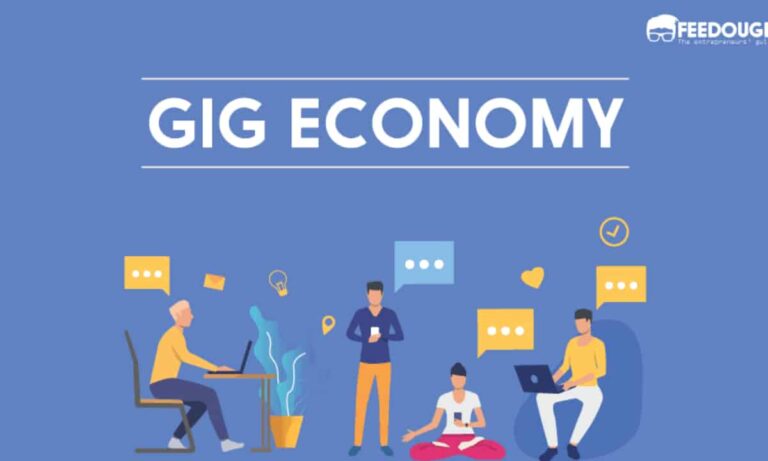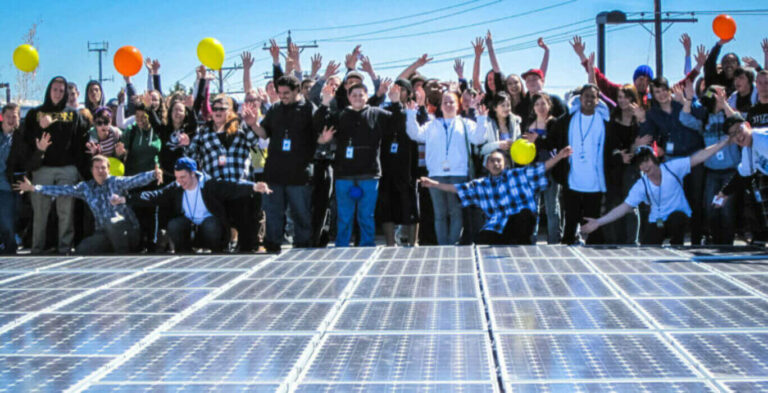Gig economy: Meaning, opportunities, advantages & more
What exactly is the gig economy and what does it hold for you, your job, and your future? Let us take a closer look.

The Internet is also disrupting the traditional workplace. Empowered by improvements in computing and connectivity, the gig economy is taking over many economies.
But gig work is not new. Freelancing and temporary jobs have existed for a long time. It is the recent explosion in online gig platforms that has brought a whole new twist to it all.
This new “gig economy”, as coined by Tina Brown in 2009 is characterized by remote work and digital contracts. This makes hiring easier, takes advantage of location-based price differences, and eliminates rush-hour headaches for the workers.
Will this trend continue? How is it impacting our lives and the future of employment? Here is a closer look at the gig economy and what it means for you and me.
What exactly is a gig?
In simplest terms, a gig is a temporary work contract between two parties. It is unlike traditional work arrangements where employees are engaged full time.
Gig workers are often referred to as independent contractors and the engagements might be time or contract-based.
Many jobs fall into the gig category. They can include on-demand driving as with Uber, food delivery, writing, product creation, software engineering, and more traditional freelancing jobs like photography.
The difference today is the rise of software platforms and smartphones, which have made it easier for workers and businesses to engage with each other.
The gig economy in figures
To understand how things stand, let us take a look at some figures about the gig economy and workers:
- There are over 60 million gig workers in the U.S.
- 3.3 million of these workers earn over $100,000 per annum
- About 65% are career freelancers
- Around 30% of the U.S. workforce is engaged in the gig economy
- That number comes down to about 20% in the UK and 10% across Europe
- There are over 150 million gig workers in America and Europe
- Over half of the global gig workforce lost their jobs to the Covid-19 pandemic
- Nearly half of millennials are engaged in gigs
- 40% of companies engage gig workers
- About 19% of freelancers contribute to a retirement plan
- About 45% of freelancers are consultants
- Gig workers contribute trillions of dollars to the global economy
Types of gigs
Gig work is possible in many industries and these can range from unskilled to low-skill and high-skill jobs. Online platforms make it easy for qualified gig workers to engage in their respective industries and make some money.
Some of the major gig-economy industries include:
- Transportation – This includes services where you need to drive something or someone from point A to point B. You often need a vehicle and a driver’s license for this. A good example is Uber.
- Accommodation – You need a room or larger space in your home for this one. Then you have to play the host and take care of visitors to your city. A good example is Airbnb.
- Multimedia & Creatives – From filmmakers to Photoshop experts and other related fields. The need for creative talents is very high in the gig economy. Fiverr and 99designs are great platforms for this.
- Writing – Most writing jobs online are gig-based. The competition is often high in some markets, with lots of writers from different parts of the world. But good writers are fewer and in high demand. A good example is Upwork.
- Retail – Online marketplaces also make it easier for different people to engage in e-commerce. Some of these platforms, like Etsy, focus on hand-made goods.
- Engineering – Lots of engineering jobs are gig-based. And they range from CAD designs to software engineering and web design jobs. Engineers with rare or exceptional skills are highly sought after on Upwork and Freelancer.com.
- Business Consultants – Many of the major platforms also connect business consultants with a wide range of services with potential clients. Plus there are specialized platforms like Catalant as well.
- Legal Services – Platforms like Legal Zoom and Rocket Lawyer provide easy access to legal services for private persons and businesses.
- Health & Care Services – Freelance doctors and nurses can also find gigs using online platforms like Nomad Health.
Types of gig workers
The gig economy might not be for everyone, but it works well for a wide range of people. These groups include all income levels but are differentiated by personality. Following are the most common types of workers you will find.
- Seeks Autonomy – Some people just cannot be tamed. They do not like to work under anyone, no matter the consequences. This is a dominant personality among entrepreneurs. They seek the thrill of the unknown.
- Stay-home moms – This group has been a major part of online jobs for years. Most stay-home moms prefer simple tasks they can do while taking care of the young ones. Earnings are important, but usually not the priority.
- Part-time jobbers – Employed people who need a second job often turn to gigs, as it makes it easier to manage things.
- Students – This is an evergreen pool of small gig workers. Although, you will occasionally find gifted students who make tremendous incomes through gigs.
- High-profile professionals – Lots of financially secured professionals turn to gigs to free up their time and upgrade their lifestyles while staying employed.
- Consultants – Most consultation services have traditionally been offered on a per-contract basis. So, business consultants are used to this.
Advantages of the gig economy
The advantages of the gig economy are many and this is for both employers and gig workers.
- Flexible working hours – Deal with other priorities in life
- Geographical freedom – Live where you want
- Follow your passion – The freedom to choose what to work on
- Cost savings – Employers can find cheaper labor
- Flexible & faster innovation – No lengthy recruitment processes
- Improved Efficiency – Work when you are most fit
Disadvantages of the gig economy
The gig economy also comes with many disadvantages, although this mostly affects newer and lower-earning freelancers.
- No minimum wage – There are no guarantees about how much you can make.
- No holiday pay – If you feel like holidaying, fine. But nobody pays you when you don’t work, period.
- No Job Security – If you lose a contract, then you are on your own.
- Unfair dismissals – Horrible employers often take advantage of the slightest opportunities to cheat.
- No sick pay – If you are sick, then you are on your own.
Criticisms of gig platforms (websites)
Many online gig platforms have been criticized for the exploitation of labor. This refers explicitly to those targeted at always discovering cheaper sources of labor for specific tasks.
In the process of cutting costs, the gig worker is heavily disadvantaged in the long term. In addition to dependency on the platform, the workers often get no chance for skill or communication training. And worst of all, there are no retirement plans or similar initiatives put in place by these platforms.
Uber contractors won the right to be classed as workers by the platform and not as independent contractors in 2016. CitySprint, Hermes, and Pimlico Plumbers have also lost similar court cases.
The U.S. state of California created a third worker category in 2020, which entitles gig drivers to benefits like minimum wage, mileage reimbursements, and health insurance.
Gigs & the future of employment
Gigs are here to stay. And while traditional working arrangements seem threatened, gigs cannot completely erase them.
Gigs make it easier for employers and employees to try out each other and see if they can develop a lasting relationship. But while the star rating on the platforms makes this process easier, it is the relationships that matter.
Employer and employee relationships are the basis of value creation because you can hardly beat the quality of work from truly loyal workers, temporary or otherwise. Firms that focus only on cutting costs will tend to hire different workers each time, but in truth, they are just getting less value for their lower costs.
So, great employees and employers will remain great in both traditional workplaces and the gig economy, while horrible bosses and workers will remain horrible.
It is also necessary that governments around the world enact legislation to protect the most vulnerable of the gig economy – the low-income workers.
Top gig economy platforms (sites)
There are countless online platforms out there that make it easy to find and execute the right gigs. Here is a list of the top destinations:
| Name | Industry |
| Fiverr | Wide range |
| Upwork | Wide range |
| Uber | Transport |
| Slack | Team chat app |
| Harvest | Time tracking |
| ClickUp | Project management platform |
| Zoom | Video meeting app |
| Freelancer.com | Wide range |
| Payoneer | Receive payments anywhere |
| Wise | Receive payments anywhere |
| Xiaozhu | Accommodation |
| Care.com | Health care |
| Amazon Flex | Transportation |
| City Sprint | Transportation |
| Farmdrop | Food delivery |
| Deliveroo | Food delivery |
| DoorDash | Food delivery |
| Uber Eats | Food delivery |
| Mechanical Turk | Micro tasks |
| Catalant | Business consulting |
| 99designs | Media |
| Rover.com | Dog walking service |
| YourMechanic | Connects car owners with mechanics |
| Pager | Health care |
| The Food Assembly | Farmer’s market |
| Bird | Electric scooter sharing |
You can find more platforms on this gig economy companies Wikipedia page.
Conclusion
Reaching the end of this post about the gig economy, it should be obvious that gigs are here to stay and more innovation is also on the way.
It is left for you to search yourself and see if this is something for you. And if you do like the idea, then why not try out a gig or two?





